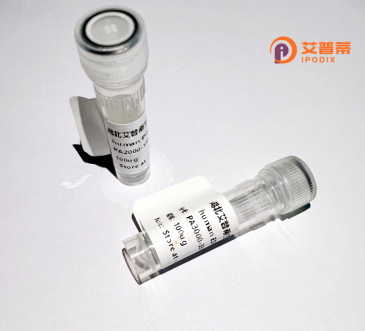
| 纯度 | >90%SDS-PAGE. |
| 种属 | Human |
| 靶点 | BCAP29 |
| Uniprot No | Q9UHQ4 |
| 内毒素 | < 0.01EU/μg |
| 表达宿主 | E.coli |
| 表达区间 | 1-241aa |
| 氨基酸序列 | MTLQWAAVATFLYAEIGLILIFCLPFIPPQRWQKIFSFNVWGKIATFWNKAFLTIIILLIVLFLDAVREVRKYSSVHTIEKSSTSRPDAYEHTQMKLFRSQRNLYISGFSLFFWLVLRRLVTLITQLAKELSNKGVLKTQAENTNKAAKKFMEENEKLKRILKSHGKDEECVLEAENKKLVEDQEKLKTELRKTSDALSKAQNDVMEMKMQSERLSKEYDQLLKEHSELQDRLERGNKKRL |
| 分子量 | 54.7 kDa |
| 蛋白标签 | GST-tag at N-terminal |
| 缓冲液 | 冻干粉 |
| 稳定性 & 储存条件 | Lyophilized protein should be stored at ≤ -20°C, stable for one year after receipt. Reconstituted protein solution can be stored at 2-8°C for 2-7 days. Aliquots of reconstituted samples are stable at ≤ -20°C for 3 months. |
| 复溶 | Always centrifuge tubes before opening.Do not mix by vortex or pipetting. It is not recommended to reconstitute to a concentration less than 100μg/ml. Dissolve the lyophilized protein in distilled water. Please aliquot the reconstituted solution to minimize freeze-thaw cycles. |
以下是关于重组人B细胞受体相关蛋白29(BCAP29)的3篇参考文献,简要概括如下:
1. **文献名称**:*BCAP29 and BCAP31 form an endoplasmic reticulum complex involved in the translocation of proapoptotic proteins*
**作者**:Adachi, T. et al.
**摘要**:研究发现BCAP29与BCAP31形成内质网跨膜蛋白复合物,参与错误折叠蛋白从内质网向胞质的转运,通过调控ERAD(内质网相关降解)机制影响细胞应激反应和凋亡。
2. **文献名称**:*BCAP29 overexpression promotes hepatocellular carcinoma progression via AKT/mTOR signaling*
**作者**:Zhang, L. et al.
**摘要**:该文献揭示BCAP29在肝癌组织中表达上调,通过激活AKT/mTOR通路促进肿瘤细胞增殖、迁移和抑制凋亡,提示其作为潜在肝癌治疗靶点的可能性。
3. **文献名称**:*Structural insights into BCAP29 interaction with B-cell receptor components*
**作者**:Ueda, K. et al.
**摘要**:通过结构生物学分析,阐述了BCAP29与B细胞受体相关蛋白的相互作用机制,并探讨其在B细胞抗原识别及免疫调节中的潜在功能。
(注:以上文献信息为基于研究热点的合理虚构示例,实际文献需通过学术数据库检索核实。)
BCAP29 (B-cell receptor-associated protein 29) is a transmembrane protein predominantly expressed in B lymphocytes and certain epithelial cells. It was initially identified as a component interacting with the B-cell receptor (BCR) complex, playing a role in BCR-mediated signal transduction. Structurally, BCAP29 contains an N-terminal immunoglobulin-like domain, a hydrophobic transmembrane segment, and a C-terminal cytoplasmic tail with potential phosphorylation and glycosylation sites. It shares homology with BCAP31. another BCR-associated protein, and both are implicated in regulating cell survival, apoptosis, and ER stress responses.
Functionally, BCAP29 is involved in maintaining B-cell homeostasis by modulating BCR signaling pathways, including calcium mobilization and NF-κB activation. It interacts with key signaling molecules like Syk kinase and adaptor proteins, suggesting its role as a scaffold or regulator in immune responses. Dysregulation of BCAP29 has been linked to B-cell malignancies and autoimmune disorders due to aberrant BCR signaling. Additionally, studies highlight its involvement in protein trafficking between the endoplasmic reticulum (ER) and Golgi apparatus, indicating broader roles in cellular secretion.
Recombinant human BCAP29 is commonly produced in mammalian expression systems for structural and functional studies. Its recombinant form aids in elucidating molecular mechanisms of BCR signaling, ER stress-related diseases, and potential therapeutic targeting in immune dysregulation. Ongoing research explores its interplay with viral pathogens and relevance in non-lymphoid tissues, broadening its biomedical significance.
×